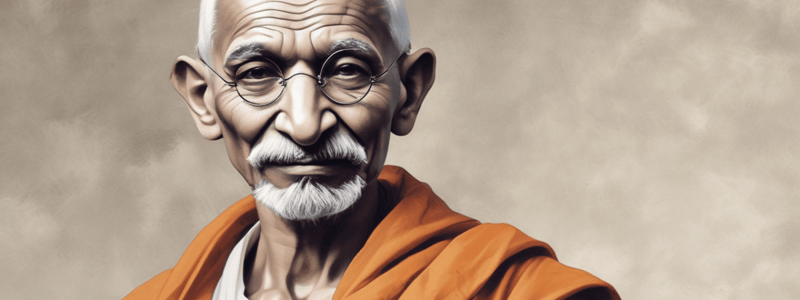Podcast
Questions and Answers
When did Mahatma Gandhi return to India?
When did Mahatma Gandhi return to India?
Mahatma Gandhi returned to India in 1915.
Where was Mahatma Gandhi born?
Where was Mahatma Gandhi born?
- India (correct)
- South Africa
- England
- The United States
What did Mahatma Gandhi wear to identify himself with India's rural poor?
What did Mahatma Gandhi wear to identify himself with India's rural poor?
Mahatma Gandhi wore a short dhoti woven with hand-spun yarn to identify himself with India's rural poor.
What did Gandhi do to identify with India's rural poor?
What did Gandhi do to identify with India's rural poor?
What was the indirect goal of Gandhi's last hunger strike in Delhi?
What was the indirect goal of Gandhi's last hunger strike in Delhi?
What was the last hunger strike Gandhi undertook?
What was the last hunger strike Gandhi undertook?
Flashcards are hidden until you start studying
Study Notes
- Mahatma Gandhi was born on October 2, 1869, in a Hindu family in coastal Gujarat, India.
- He trained as a lawyer and moved to South Africa in 1893 to represent an Indian merchant in a lawsuit.
- In 1915, aged 45, he returned to India and soon set about organising peasants, farmers, and urban labourers to protest against excessive land-tax and discrimination.
- Gandhi assumed leadership of the Indian National Congress in 1921 and led nationwide campaigns for easing poverty, expanding womens rights, building religious and ethnic amity, ending untouchability, and, above all, achieving swaraj or self-rule.
- Gandhi adopted the short dhoti woven with hand-spun yarn as a mark of identification with Indias rural poor. He began to live in a self-sufficient residential community, to eat simple food, and undertake long fasts as a means of both introspection and political protest.
- In the months following, he undertook several hunger strikes to stop the religious violence.
- The last of these, begun in Delhi on January 12, 1948, had the indirect goal of pressuring India to pay out some cash assets owed to Pakistan.
Mahatma Gandhi was a successful lawyer who moved to South Africa in 1893 to represent an Indian merchant in a lawsuit. He returned to India in 1915 and soon started to organise peasants, farmers, and urban labourers to protest against excessive land-tax and discrimination. He became the leader of the Indian National Congress in 1921 and led nationwide campaigns for easing poverty, expanding womens rights, building religious and ethnic amity, ending untouchability, and, above all, achieving swaraj or self-rule. Gandhi adopted the short dhoti woven with hand-spun yarn as a mark of identification with Indias rural poor. He began to live in a self-sufficient residential community, to eat simple food, and undertake long fasts as a means of both introspection and political protest. In the months following, he undertook several hunger strikes to stop the religious violence. The last of these, begun in Delhi on January 12, 1948, had the indirect goal of pressuring India to pay out some cash assets owed to Pakistan.
Studying That Suits You
Use AI to generate personalized quizzes and flashcards to suit your learning preferences.



